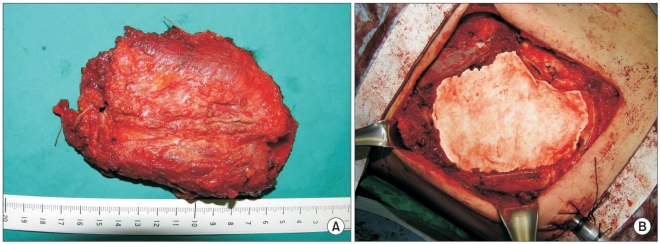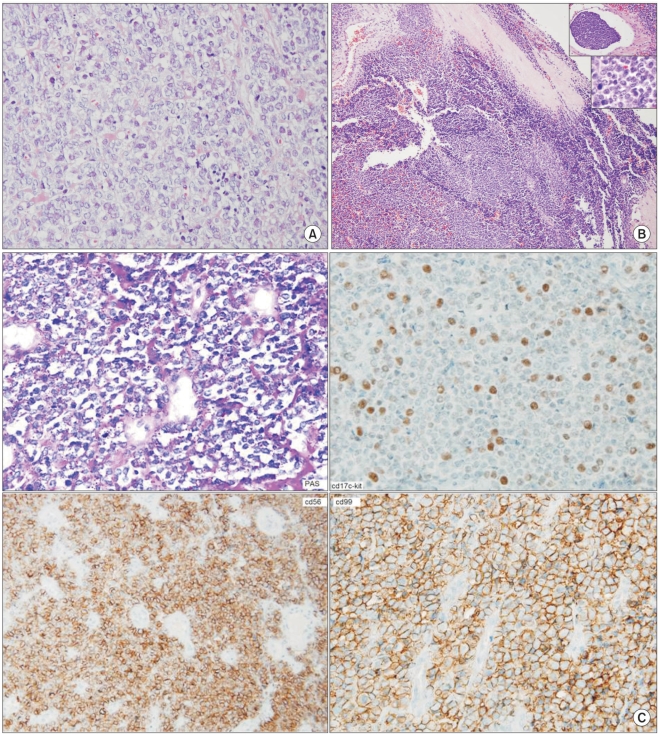Cancer Res Treat.
2009 Jun;41(2):108-112.
Multimodal Treatment of Primary Extraskeletal Ewing's Sarcoma of the Chest Wall: Report of 2 Cases
- Affiliations
-
- 1Department of Thoracic and Cardiovascular Surgery, School of Medicine, Konkuk University Chungju Hospital, Chungju, Korea. timesgoby@naver.com
- 2Department of Thoracic and Cardiovascular Surgery, School of Medicine, Konkuk University Hospital, Seoul, Korea.
- 3Department of Thoracic and Cardiovascular Surgery, Seoul Paik Hospital, Inje University College of Medicine, Seoul, Korea.
- 4Department of Internal Medicine, School of Medicine, Konkuk University, Seoul, Korea.
- 5Department of Internal Medicine, School of Medicine, Konkuk University Chungju Hospital, Chungju, Korea.
Abstract
- Extraskeletal Ewing's sarcoma (EES) is a type of Ewing's sarcoma that arises in soft tissue and is now regarded as a member of a family of small round cell neoplasms of bone and soft tissue, including primitive neuroectodermal tumors (PNETs). EES occurs predominantly in adolescents and young adults between the ages of 10 and 30 years. The disease follows an aggressive course with a high recurrence rate. The presence of a distant metastasis is also common. EES arises in the soft tissue of either the trunk or extremities. We recently experienced two cases of EES that occurred in the chest wall. The two patients underwent wide resection and combined radiochemotherapy. There was no evidence of disease 30 and 22 months, respectively, after surgery. Although extremely rare, EES should be considered in the differential diagnosis of chest wall tumors. We report two cases of EES with a brief review of the literature.
MeSH Terms
Figure
Reference
-
1. Raney RB, Anderson JR, Andrassy RJ, Crist WM, Donaldson SS, Maurer HM, et al. Soft-tissue sarcomas of the diaphragm: a report from the Intergroup Rhabdomyosarcoma Study Group from 1972 to 1997. J Pediatr Hematol Oncol. 2000; 22:510–514. PMID: 11132218.
Article2. Guiter GE, Gamboni MM, Zakowski MF. The cytology of extraskeletal Ewing's sarcoma. Cancer. 1999; 87:141–148. PMID: 10385445.3. Enzinger FM, Weiss SW. Soft tissue tumor. 1995. 2nd ed. St. Louis: CV Mosby;p. 952–959.4. Enzinger FM, Weiss SW. Enzinger FM, Weiss SW, editors. Extraskeletal Ewing's sarcoma/primitive neuroectodermal tumor family. Soft tissue sarcoma. 2001. 4th ed. St. Louis MO: Mobis;p. 1289–1308.5. Ahmad R, Mayol BR, Davis M, Rougraff BT. Extraskeletal Ewing's sarcoma. Cancer. 1999; 85:725–731. PMID: 10091746.
Article6. Raney RB, Asmar L, Newton WA Jr, Bagwell C, Breneman JC, Crist W, et al. Ewing's sarcoma of soft tissues in childhood: a report from the intergroup rhabdomyosarcoma study, 1972 to 1991. J Clin Oncol. 1997; 15:574–582. PMID: 9053479.
Article7. Desai KI, Nadkarni TD, Goel A, Muzumdar DP, Naresh KN, Nair CN, et al. Primary Ewing's sarcoma of the cranium. Neurosurgery. 2000; 46:62–68. PMID: 10626936.
Article8. Rosen G, Caparros B, Nirenberg A, Marcove RC, Huvos AG, Kosloff C, et al. Ewing's sarcoma: ten year experience with adjuvant chemotherapy. Cancer. 1981; 47:2204–2213. PMID: 7226113.




